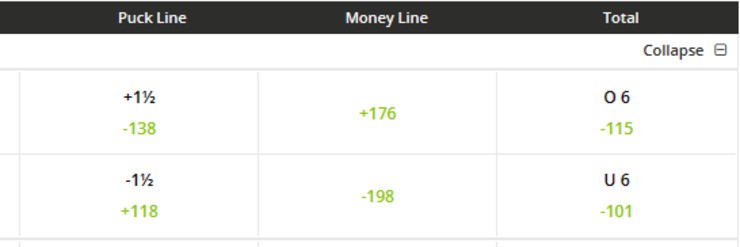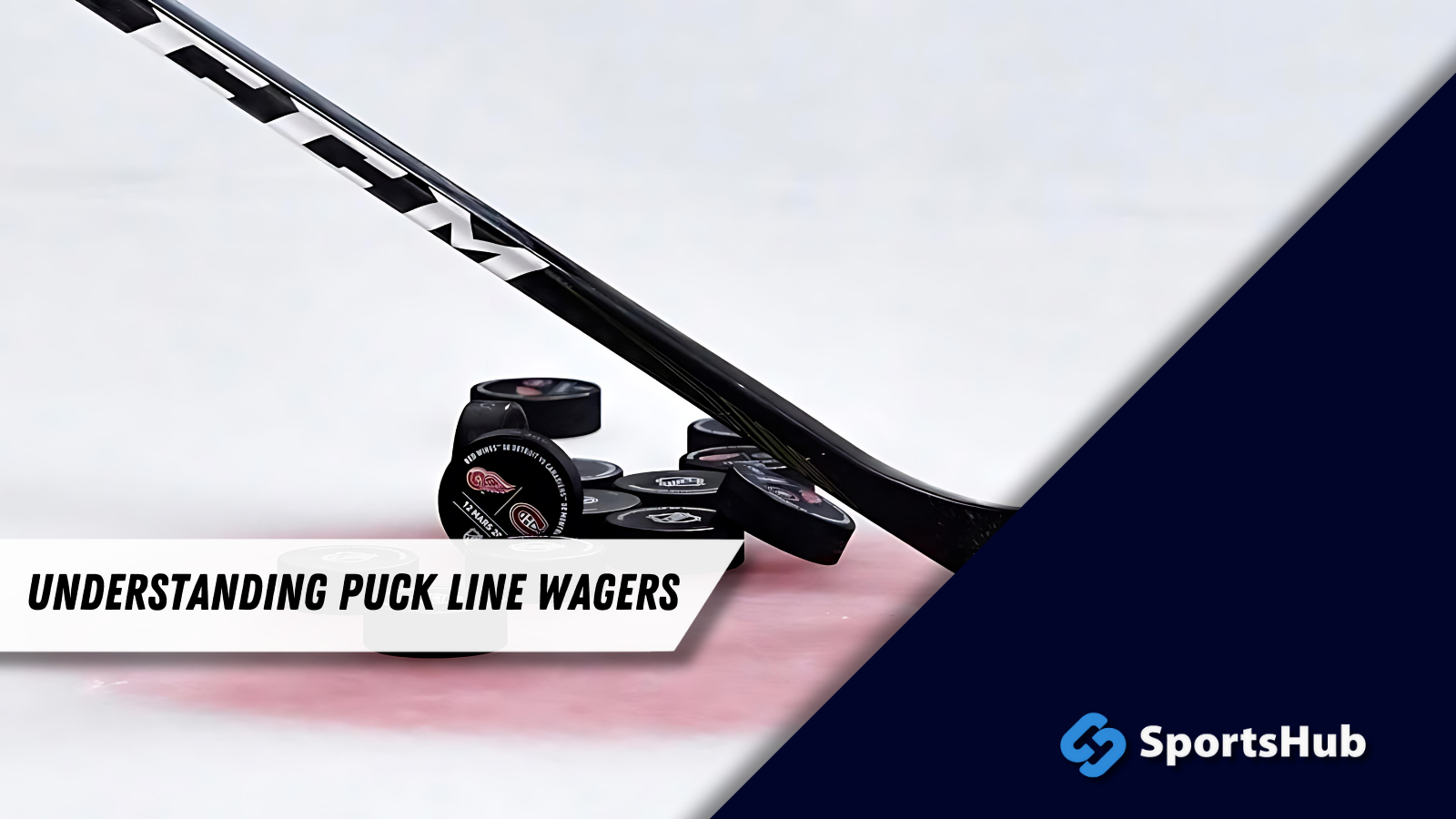Table of Contents
A puck line wager in ice hockey is a type of bet that involves betting on a team to either win by a certain number of goals (usually 1.5 goals) or to keep the game close by not losing by more than that number of goals. It’s similar to a point spread bet in other sports.
Check out our youtube video explaining puck lines!
What is the purpose of a puck line?
The purpose of a puck line in ice hockey betting is to provide an alternative way for bettors to wager on a game when one team is heavily favored over the other. It serves several purposes:
- Balance the Odds: In hockey, there are often games where one team is a significant favorite, and the moneyline odds for that team may not offer attractive payouts. The puck line introduces a point spread to make the bet more competitive and appealing by giving the underdog a virtual head start and requiring the favorite to win by a certain margin.
- Increase Betting Options: Puck lines provide bettors with more options and flexibility when betting on hockey games. Instead of simply betting on which team will win or lose, bettors can choose to bet on whether a team will win by a specified number of goals or keep the game close.
- Offer Better Payouts: Betting on the puck line for the underdog can result in more significant potential payouts than betting on the money line for the same team. This can be enticing for bettors looking for higher potential returns.
- Add Excitement: Puck lines can add excitement and engagement to hockey games, creating additional opportunities for in-game action and strategy. Bettors can follow the game closely and root for specific outcomes based on their chosen puck line.
In summary, a puck line aims to provide a different way to bet on hockey games, especially when there’s a clear favorite, by introducing a point spread that can balance the odds and offer more appealing betting options for both favorites and underdogs.
Explanation of a Puck Line Wager
A puck line wager is a type of bet commonly used in ice hockey betting, particularly in North America. It’s similar to the point spread bet in other sports like basketball or football but adapted for hockey.
The sportsbook typically sets a point spread at 1.5 goals in a puck line wager. Here’s how it works:
- Favorite: If you bet on the favorite, they must win the game by more than 1.5 goals for your bet to be a winner. So, if the favorite wins the game by two or more goals, your puck line bet on the favorite would be successful.
- Underdog: If you bet on the underdog, they can win the game outright, or even if they lose by just one goal, your bet on the underdog would be a winner.
Puck line bets are often used to create more balanced odds when there’s a clear favorite in a hockey game. It allows bettors to get better odds on the favorite or higher potential payouts on the underdog.
For example, if the Toronto Maple Leafs are a strong favorite to beat the Ottawa Senators, the moneyline odds on the Maple Leafs might not offer much value. In this case, you could choose to bet on the Maple Leafs with a puck line of -1.5. If they win by two or more goals, your payout would be better than a simple moneyline bet on the Maple Leafs.
Conversely, if you believe the Senators can keep the game close or potentially pull off an upset, you might bet on them with a +1.5 puck line. Your bet will be successful if they win outright or lose by just one goal.
Puck line bets can be an interesting way to add variety to your ice hockey betting strategy, but they come with their own risks and rewards, so it’s important to understand how they work and consider the specific circumstances of each game before placing a wager.
When did Puck Line Wager become popular?
The puck line wager became popular in ice hockey betting as the popularity of sports betting, in general, grew. While I don’t have specific historical data on when it first appeared, it likely gained popularity alongside the growth of sports betting markets in North America, particularly in the United States and Canada, where ice hockey is a major sport.
The concept of point spread betting, which includes puck lines in hockey, has been used in other sports for a long time. It was adapted for hockey to give bettors more options and balance the odds when a game’s a clear favorite. The exact timeline of its popularity growth may vary, but it’s been a common betting option for quite some time, especially in the context of the NHL (National Hockey League).
Bet puck lines on periods.
Some sportsbooks offer puck line bets specifically for individual periods in hockey games. These period-specific puck line bets work similarly to regular ones, but they apply to the outcome of a single period (typically the first or second) rather than the entire game.
For example, if you’re betting on the first-period puck line, you might see odds like:
- Team A -0.5 (+150)
- Team B +0.5 (-200)
In this scenario, if you bet on Team A, they would need to lead by at least one goal at the end of the first period for your bet to win. If you bet on Team B, they could be leading, tied, or even trailing by just one goal, and your bet would be a winner.
Betting on period-specific puck lines can appeal to bettors who want to focus on shorter game segments and take advantage of potentially different dynamics during those periods. Remember that the odds for period-specific puck lines can vary significantly from the full-game puck line, as the scoring dynamics and strategies can differ between periods.
As with any form of sports betting, it’s important to research the teams, assess the goaltender matchups, and consider other relevant factors before placing period-specific puck line bets. Be sure to check with your chosen sportsbook to see if they offer this type of wager, as not all sportsbooks provide period-specific puck line betting options.

What is an alternate puck line?
An alternate puck line, also known as an “alternate line,” is a variation of the standard puck line in ice hockey betting. It allows bettors to wager on a different point spread than the one offered in the primary puck line, providing more options and potentially different odds. Depending on the bettor’s preference, the alternate puck line can be narrower or wider than the standard one.
Here’s an example of how an alternate puck line works:
Standard Puck Line:
- Team A -1.5 (+150)
- Team B +1.5 (-200)
In the standard puck line, Team A is the favorite and must win the game by at least two goals for a bet on them to be a winner. Team B, the underdog, can lose by one goal or win the game outright for a bet on them to be successful.

Alternate Puck Line:
- Team A -2.5 (+300)
- Team B +2.5 (-400)
In this alternate puck line, Team A must win the game by at least three goals for a bet on them to be a winner. Team B can lose by up to two goals, and a bet on them would be successful. However, because the point spread is wider, the odds for Team A to cover the spread have increased, while the odds for Team B to cover the spread have decreased.
Bettors may use alternate puck lines to tailor their bets to their expectations for a game. If they believe a favorite will win by a larger margin, they might bet on an alternate puck line with a wider spread to get better odds. Conversely, if they think an underdog will keep the game close, they might bet on an alternate puck line with a narrower spread to increase their potential payout.
It’s important to note that the odds for alternate puck lines can vary significantly from the standard puck line, so bettors should consider their game analysis and risk tolerance when choosing which puck line to wager on.
What are the chances of winning when betting on -1.5 puck lines
The winning percentage for betting on -1.5 puck lines will generally be influenced by the following:
- Team Strength: Stronger teams with a history of high-scoring games may have a higher success rate when it comes to covering the -1.5 puck line.
- Opponent Strength: The quality of the opposing team can affect the likelihood of a team covering the -1.5 puck line. Weaker opponents may be more susceptible to losing by a larger margin.
- Home vs. Away Games: Home teams tend to perform better in hockey, so this can impact the success rate of -1.5 puck line bets.
- Goaltending: The performance of the starting goaltenders can play a significant role in whether a team wins by the required margin or not.
- Injuries and Lineup Changes: Injuries to key players or significant changes in team lineups can affect a team’s ability to cover the -1.5 puck line.
- Recent Trends: Teams’ current scoring and defensive trends, as well as their performance on the power play and penalty kill, can also impact the outcome of -1.5 puck line bets.
To get the most accurate and up-to-date information on winning percentages for -1.5 puck line bets, it’s best to consult reputable sports betting websites, statistics providers, or sportsbooks that offer historical data and analysis for hockey betting. Remember that past performance does not guarantee future results, and successful sports betting requires thorough research and careful consideration of all relevant factors.
Three tips when betting puck lines
Analyze Team Form and Strength:
Before placing a puck line bet, assess the current form and strength of the teams involved. Look at their recent performance, including their home and on-the-road records. Consider factors like injuries to key players, line changes, and any recent trends. A team that has been scoring many goals and playing solid defense might be a good candidate for a puck line bet.
Understand Goalie Matchups:
Goaltending is a critical factor in hockey, and the matchup between the starting goalies can significantly impact the game’s outcome. Research the goaltenders’ recent performances, save percentages, and records against the opposing team. If there’s a clear advantage for one team’s goaltender, it can make a difference in your puck line bet.
Look for Value:
Puck line bets are often used to find value in games where one team is a heavy favorite. However, it’s essential to assess whether the odds offer good value. Sometimes, the puck line odds on the favorite may not provide enough value, and it may be wiser to consider other betting options or to avoid the game altogether. Always compare the potential payout to the level of risk involved.
Key Factors for Puck Line Betting
- Special teams performance (power play and penalty kill).
- Head-to-head history between the two teams.
- Recent scoring trends for both teams.
- Home ice advantage.
Remember that puck line bets come with increased risk compared to moneyline bets, requiring a team to win by a specific margin. While they can offer better odds and potential payouts, it’s essential to do your research and use these tips to make informed betting decisions. As with any form of sports betting, responsible bankroll management is crucial to avoid excessive losses.
Please ensure to visit our hockey homepage and team page to access the most up-to-date information and news updates.





